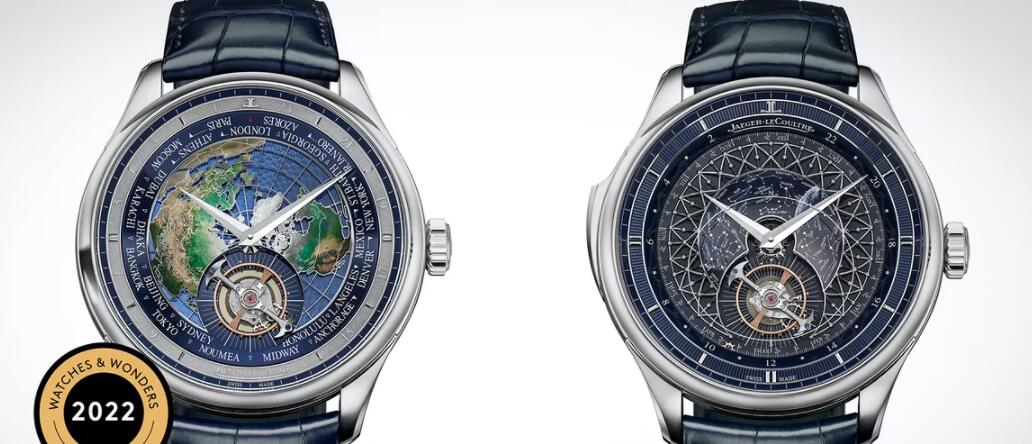Jaeger-LeCoultre has, over the last twenty years, produced a truly astounding number of highly complex and often multi-axis tourbillons (Spherotourbillon, anyone?). One of its most serenely beautiful complications, however, is the caliber 945. The movement was introduced all the way back in 2010 but it has been produced by Jaeger-LeCoultre in several variations since then (most recently, if my memory’s still reasonably reliable, in 2020). There is nothing quite like the Jaeger-LeCoultre Master Hybris Artistica Calibre 945 from any other maker. It’s basically an orbital flying tourbillon and minute repeater – the one minute flying tourbillon orbits around the dial once every sidereal day and is, in every iteration, accompanied by a planispheric sky chart.
This year, at Watches & Wonders 2022, Jaeger-LeCoultre has introduced two new versions of its orbital tourbillon. The 945 Hybris Aristica which is a new version of the caliber 945 – the basic functionality is the same as in 2010 – in two new versions. The rose gold model has a grisaille (monochrome) enamel, while the white gold model has a dial made of a fine network of silvered metal, both of which are dome-shaped. The second is the Master Grand Tradition Grand Caliber 948, which is an orbital tourbillon with a solar day period rather than a sidereal day period – and with a world time function; this is the first time JLC has married the orbital tourbillon with a world timer.
The Master Grande Tradition Caliber 948 is, more or less, a classic implementation of the world time complication, but with additional visual and horological pizzaz, courtesy of the orbital tourbillon. As is often the case with world time watches, there is a depiction of the Earth on the dial, as seen from a position directly above the North Pole. In the Caliber 948, however, the continents aren’t on the dial – instead, they float above it, on a domed skeleton that represents the lines of latitude and longitude. The continents themselves are executed in grand feu champlevé enamel, with the colored enamel laid over a white gold base, and the area under the dial is in translucent blue lacquer over a guilloché pattern meant to evoke the ocean waves.
The Earth and the tourbillon rotate counterclockwise once every 24 hours, and the hour hand can be set to local time with the crown, in one-hour jumps, forwards or backwards. It’s a large-ish watch, with a 43mm x 14.13mm white gold case but hey, you have a whole planet you gotta fit in there (well, half a planet). Caliber 948 is a limited edition of 20 pieces.
The Jaeger-LeCoultre Master Hybris Artistica Calibre 945 is one of my personal favorites among JLC’s very large repertoire of complicated watches. The two complications are reasonably well-known, if not exactly commonplace – a minute repeater, and an indication of sidereal time, with a planispheric star chart. The tourbillon orbits once per sidereal day, counterclockwise, with the oval outline surrounding it representing the horizon. A sidereal day is shorter than a solar day, at about 23 hours, 56 minutes, and 4.1 seconds. The reason for this is that while a solar day is the number of hours it takes for the Sun to return to a given place in the sky, a sidereal day, on the other hand, is the amount of time necessary for a fixed star to return to a given place in the sky. As the Earth rotates, it’s also moving along its orbit and because the Sun is relatively close to the Earth, the Earth actually has to rotate slightly more than one full rotation to bring the Sun back to the same place in the sky. The stars are so far away, however, that this parallax effect is, for all intents and purposes, nonexistent.
A small sun-shaped pointer on the edge of the dial shows the solar time on a 24-hour scale, and also functions as an indicator for the zodiacal month (that is, it shows which sign of the Zodiac the Sun is in). Finally, the hour and minute hands show mean civil time.
Grisaille enamel, used for the Galaxia, is a technique in which successive layers of white enamel are overlaid over a blue or black base – since the white enamel is thickest over the lightest areas, the technique produces a much more pronounced sense of depth than conventional enameling. The enamel is applied to a shallow dome, which rotates over a black disc (for the white gold or pink gold models).
The Jaeger-LeCoultre Master Hybris Artistica Calibre 945 is available in white or pink gold, in a very limited edition of five watches in each metal (the pink gold model is called the Galaxia and the white gold, Atomium).
